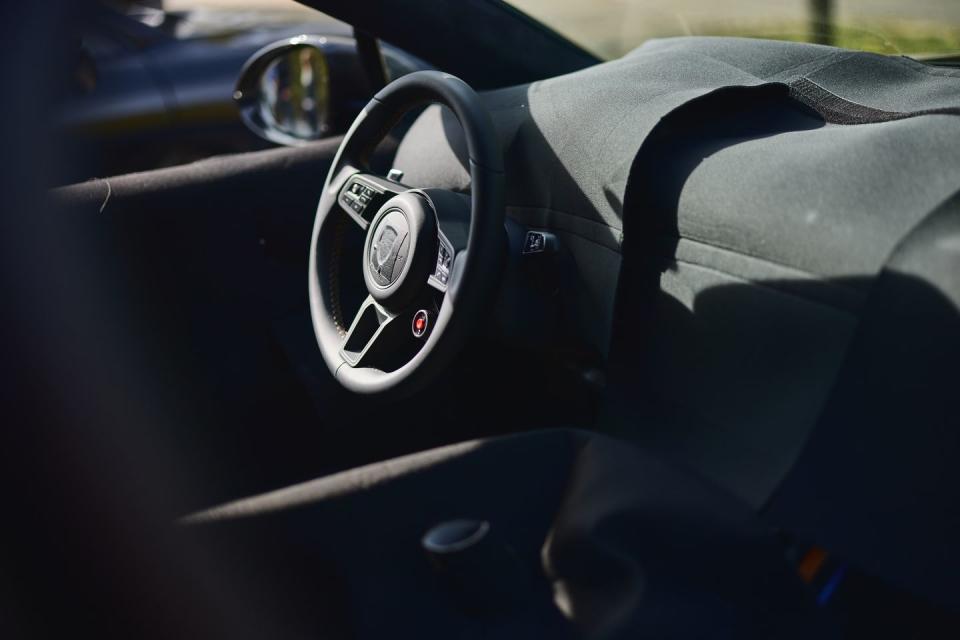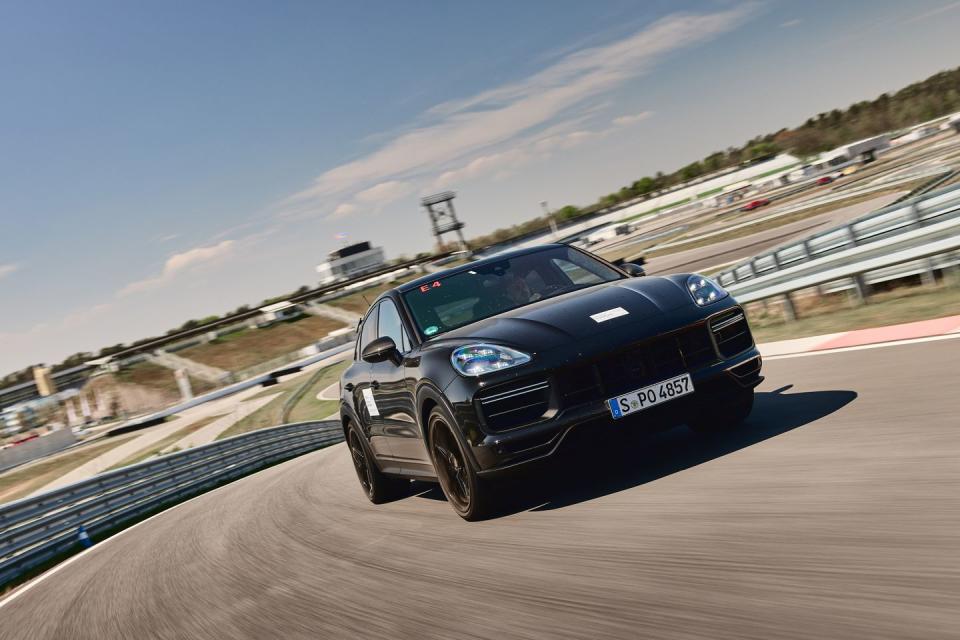2022 Porsche Cayenne Turbo Coupe Prototype: Heavy Artillery

Porsche knows how its customers tick. When the affluent masses demand a Cayenne that is faster, more powerful, and even more thrilling to drive than the current, already mighty Cayenne Turbo coupe, the German manufacturer tends to listen. This is how Porsche describes its decision to build atop its most powerful non-hybrid Cayenne models with a new ultra-high-performance version, which is aimed at bringing the fight to the Cayenne's Volkswagen Group platform-mate, the Lamborghini Urus.
Set to sell alongside the existing Cayenne Turbo coupe when it goes on sale in the United States late next month, the idea for the new four-seat model was triggered by customers seeking even-greater performance in a road-going SUV, according to Cayenne product line manager Rico Loescher. "It's a logical progression to the various performance-enhancing options we already have for the Turbo coupe," he says. To experience the new über-Cayenne for ourselves, we went to Porsche's hometown of Stuttgart, Germany, to sample a near-production prototype. We won't know the exact name of the new model until it's formally unveiled at the end of June, but we can confirm it will be offered only in the Cayenne's coupe body style.

Our development mule sports a mild disguise, as is usual at this late stage of development. However, the key changes are easily recognizable. First, there's an updated front fascia with a revised splitter and larger cooling ducts for the engine and front brakes. The existing coupe's optional carbon-fiber roof also is featured, and the rear roof spoiler has gained additional side extensions. Although it's only visible at speed when it deploys from the tailgate, there's also a larger active rear spoiler for increased downforce. Rounding off the exterior tweaks is a modified carbon-fiber diffuser, which Porsche claims reduces turbulence and speeds the flow of air beneath the SUV for added high-speed stability. It also houses a pair of centrally mounted tailpipes that form part of a new titanium sports exhaust system. Rolling stock consists of standard 22-inch Neodyme wheels shod with sticky Pirelli P Zero Corsa summer tires, sized 285/35R-22 in front and 315/30R-22 at the rear.
Modifications to the interior are rather subtle. Porsche remains proud of the changes it made to the cabin of the third-generation Cayenne, and it clearly doesn't think the new performance model requires any major alterations. There is some new Alcantara trim with contrasting stitching and a thicker-rimmed sports steering wheel with a Sport Response button. But it's not far removed from the standard model. Reflecting its sporting brief, the new model will only be available with four seats; the three-across rear bench is replaced by two individual thrones.

It's the engine, however, that Loescher is keen to detail as we begin to make our way out of Stuttgart in search of smooth German country roads and empty autobahns. He says the Cayenne Turbo's twin-turbocharged 4.0-liter V-8 has received a series of detailed changes that liberate an additional 90 horsepower, upping it from 541 to 631 horses. That's 40 more ponies than the same engine produces in the Audi RS Q8 but 10 fewer horses than in the Urus. It's also 14 and 28 horsepower more than you'll get in a BMW X6 M Competition and a Mercedes-AMG GLE63 S coupe, respectively.
But this still isn't the most powerful Cayenne model. That honor continues to rest with the Turbo S E-Hybrid models, which combine a slightly less stressed version of the V-8 with an electric motor and a 17.9-kWh battery to deliver 670 horsepower. The Cayenne Turbo coupe's increase in power is accompanied by a 60-lb-ft bump in torque for a total of 627. We know that some of the major changes include a new engine control module and more turbocharger boost, but Porsche is holding back on specifics until closer to the SUV's launch. A conventional ZF eight-speed torque-converter automatic transmission handles shifting duties and features revised programming. The front-to-rear torque split of the standard all-wheel-drive system will vary from a nominal 40/60 percent to a heavily rear-biased 20/80 percent when you're pushing hard.

The prototype's updated engine is smooth and hugely flexible, with the generous reserve of torque giving it outstanding low-rpm grunt. But its explosive midrange power is what really highlights the driving experience. Bolstered by the revisions to the transmission, acceleration is simply ferocious. Porsche has yet to make any performance claims, but Loescher suggests it should be quicker than the Urus to 60 mph. For the record, the Lambo currently is the quickest production SUV we've ever tested with a 3.1-second run to 60 mph.
As you'd probably expect, for this new range-topping Cayenne to achieve Porsche's goals of providing "best-in-class performance" and a "high level of everyday usability," it receives a number of chassis updates that have been honed on the Nürburgring Nordschleife. We didn't visit the 'Ring on our drive, but we did get to probe the Cayenne's limits at Porsche's driver training facility at the Hockenheim Ring. Underpinning the new model is an upgraded adaptive air spring with six adjustable ride heights, the most performance-oriented of which receives a 0.3-inch lower ride height than the regular Cayenne Turbo coupe. Active anti-roll bars and rear-wheel steering plus gigantic carbon-ceramic brakes will be standard.

Let loose on the track or a suitably clear and windy road, the first thing you notice is the chassis's sharper responses. Regardless of the drive mode, the new king-of-the-hill Cayenne always feels more urgent in its actions than the existing Turbo coupe. Its steering feels more heavily weighted, and its turn-in behavior is crisper. According to Loescher, this can be attributed in part to an additional half-degree of negative camber at the front wheels, as well as the slightly wider track provided by the new wheel and tire package.
Feedback is minimal through the prototype's thick-rimmed steering wheel, but there's plenty of bite at the front end. Rear-wheel steering continues to make the Cayenne feel much smaller on the road than it actually is. Updated to provide a greater degree of rear-steering angle, it quickly rotates the rear end to help quell any understeer when pushing hard on challenging roads. Combined with the lowered ride height, the prototype's revised active anti-roll bars and torque-vectoring rear differential almost eliminate body roll and lend the SUV a terrifically neutral attitude in corners.

Ride quality is predictably firm. Loescher says that the dampers are 15 percent stiffer than those used by the current Cayenne Turbo coupe. Despite the added firmness, the new model still manages to deliver sufficient compliance over bumps. The tradeoff is a high level of road noise. The firmer underpinnings and performance tires may do wonders for the handling without destroying the ride, but refinement suffers in the process, especially on coarse road surfaces.
Porsche has yet to reveal how much the new super Cayenne Turbo coupe will cost. But going by the extent of the changes, it's likely to carry a handsome premium over the existing model. Figure a starting price somewhere between the current $167,550 Cayenne Turbo S E-Hybrid coupe and the $222,004 Urus. We'll know for sure soon enough. But given its awesome handling and power delivery, we're already certain that this will be a highly compelling performance vehicle, one that has the potential to set new, very high standards for hot SUVs—just as Porsche's customers apparently demand.
You Might Also Like

 Yahoo Autos
Yahoo Autos 